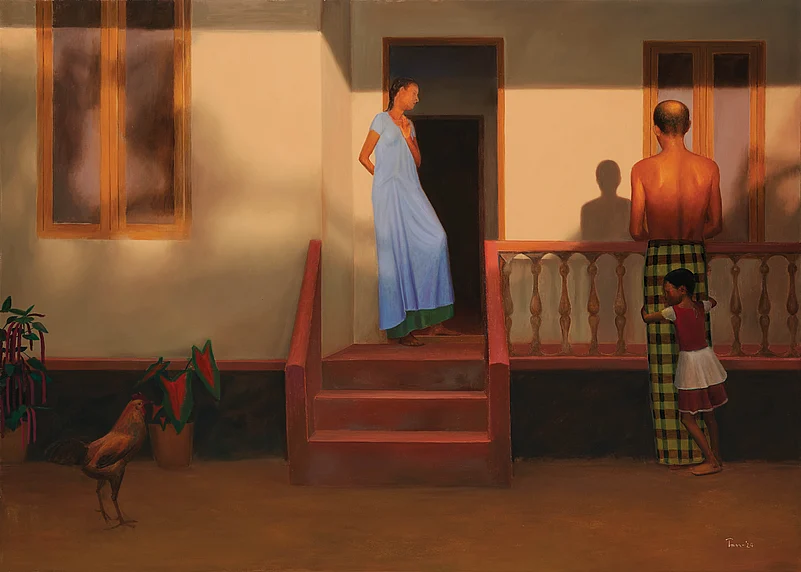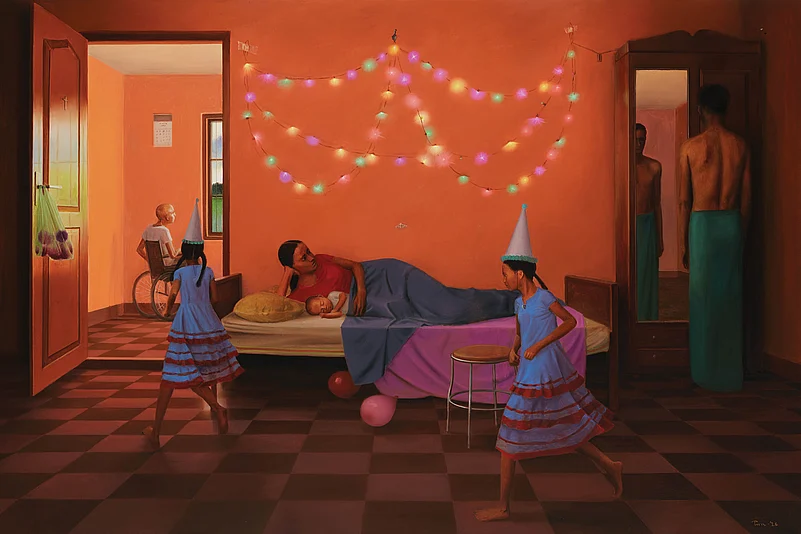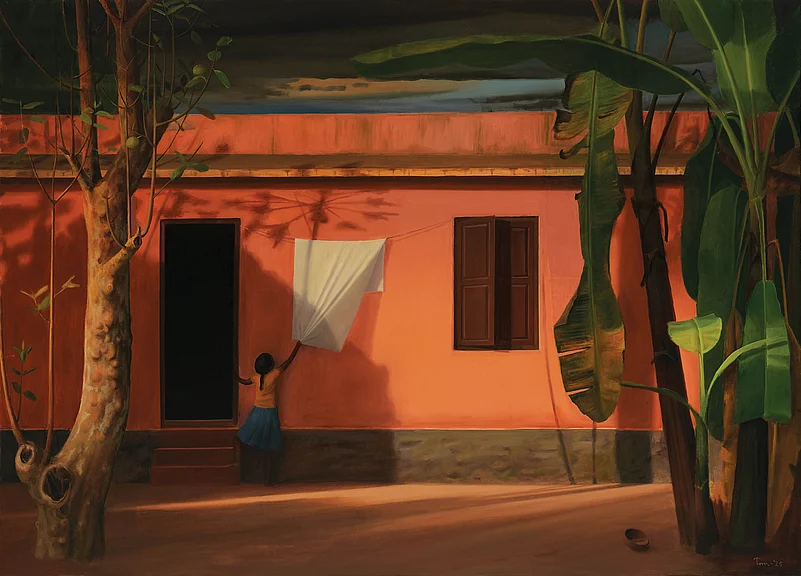
Tom Vattakuzhy's first solo exhibition in India, 'The Shadows of Absence', is grounded in rural Kerala.
The paintings speak to the deep influence of artists such as Piero della Francesca on his works.
The paintings are filled with contrasts, such as the playfulness of children and the morbidity of old age.
The initial impression you get when you walk into Tom Vattakuzhy's first solo exhibition in India, 'The Shadows of Absence', is one of immersive stillness and quietude. Grounded strongly in rural Kerala, Vattakuzhy's homeland, the paintings dwarf the viewer in many cases, being life-size. Each painting feels like a portal through which you can almost step into the frame and become one with the subjects. The viewer is then submerged in the atmosphere of the paintings, their bold bands of light and dark, their subjects who are lost in their own worlds and never acknowledge the viewer-voyeur.
Vattakuzhy, who began his career as an illustrator, was trained for a time at Santiniketan, where he met and was deeply influenced by Somnath Hore and K.G. Subramanyan. Their impact, along with his experiences of research as an illustrator, taught him to go beyond the literal and find the phenomenal.

One can see this influence in the way he constructs his work: for example, in the triptych 'The Evening Sleep Of an Old Man'. The life-size painting (6 ft by 9 ft) shows a family scene—a man, infirm in his old age, lies sleeping, while a curious child peeks from behind a wall to look at him. A woman stands in a corner, lost in thought, while a young man walks in behind the child, lost in his own world and on his phone. The painting is a study in contrasts—the morbid stillness of the man, contrasted with the youthful curiosity of the young girl; the brown study of the woman, distant from the world, with the equally distant young man who is engaged with a world beyond the room. "Women suffer most in a household situation," says the artist later, when I interview him. "So, in my paintings, I look at women with empathy."
The same qualities can be seen in 'Birthday', a painting of a similar size. It could be the same family, celebrating a birthday party with balloons, or it may not be. Either way, the painting, despite being on one canvas, has the compositional structure of a triptych—on the left is an old man looking out of a window, while children play in the foreground. The woman looks to a man standing in the right corner, half of his face visible in a mirror, Magritte-like. The painting brings out Vattakuzhy's talent of capturing movement in stillness in an almost sculptural way.
The slightly flattened perspectives, and smooth lines with minimal visible brush strokes in the paintings speak to the deep influence that certain early modern artists had on Vattakuzhy, specifically della Francesca. It also has a certain Balthus-like quality that the artist himself points out. Meanwhile, paintings such as 'The Red Ball' show Vattakuzhy's talent for capturing the nuances of lighting his subjects. No photograph can adequately capture the glow of the band of light in the painting, juxtaposed with the relative darkness the living beings in the painting are shadowed in. The work is also a fine representation of one of Vattakuzhy's other talents—if he is good at capturing apathy, he is equally good at capturing gentle moments of familial relations. The girl in this painting is comforted by a woman, perhaps her mother; in 'Lessons of Life-5', incidentally, also featuring a red ball, a man is surrounded by children at play and is entirely focused on helping a little girl walk; in 'Father and Son', a young boy is tenderly held by his father, in a pose reminiscent of the Virgin Mary.

"During my childhood, I didn't have much opportunity to see works of other artists," says Vattakuzhy. "All that I could see were the paintings in the church altar, and that too, not much, very minimal. Later on, my uncle who studied in Europe, came back home, he gave me a museum catalogue from an Italian museum. So, there I could see beautiful reproductions of many Renaissance artists and that was really inspiring to me."
Of the spiritual concerns in his paintings, Vattakuzhy says, "I belong to the Christian community, and had a kind of Christian upbringing, so a certain type of concern for humanism is embedded in me" He wouldn't even call it religious, because he doesn't want to associate it with "religion as an institution, but a kind of spiritual concern."
Throwaway objects of playfulness are found aplenty, such as the balloon in its eponymous painting – an object that, like the ball, turns up as a motif in multiple other paintings, such as 'Girl with Balloon'. In the former, the balloon almost seems like a reflection of a distant evening moon. This echo of natural features in inanimate, man-made objects recurs in other paintings as well; in 'Seller of Stars', an array of star-shaped Christmas lights shine far below a star in the twilight sky; a bird perches on a window sill in 'Sunday Afternoon', high above a toy chicken. The play of natural and artificial, animation and inanimation, continues in paintings such as 'Red Ball' and 'Lessons of Life-5', which show the intertwining of animal life with human preoccupations; a dog sitting quietly here, chickens scattering elsewhere, slugs and millipedes climbing along in a third.
There is a balancing of dichotomies in the paintings—of playfulness of children contrasted with the morbidity of old age, and a strong sense of the interior being divorced from the exterior—people amid nature, hardly paying attention to nature, which serves as an almost ironic background to the interplay of human concerns in the foreground. The silences in the paintings raise more questions than answers: why does the woman in 'The Evening Sleep of an Old Man' appear to be crying? Why does the child in 'The Red Ball' need to be comforted? Where are the inhabitants of the house under a quiet moon, with a balloon lying in the doorway, in 'The Balloon'?

The show's curator, R. Siva Kumar, Vattakuzhy's former Professor at Kala Bhavan in Santiniketan, says that the paintings reflect a kind of economy that is driven by the Middle East. "It is a remittance economy, and that also means that most families have very few male members, and the women are left behind," he says. "So, you can see that male members, even if they are there, are almost shadowy…They are almost like absences rather than presences. And of course, this means a family which is always incomplete…and he tells their stories, their loneliness."
In other words, Vattakuzhy captures the community's shifting tides, from a rural, agricultural economy to something else entirely.
"It's a comment on society in many ways, and through very, very closely observed little details," Sivakumar says.
('The Shadows of Absence: Recent Works of Tom Vattakuzhy', is on view at Vadehra Art Gallery, New Delhi, from August 21 to September 13, 2025. It is jointly presented by the Institute of Contemporary Indian Art (ICIA) and Vadehra Art Gallery.)
Rush Mukherjee is a journalist based in Kolkata who reports on art and culture, and LGBTQIA+ issues





















